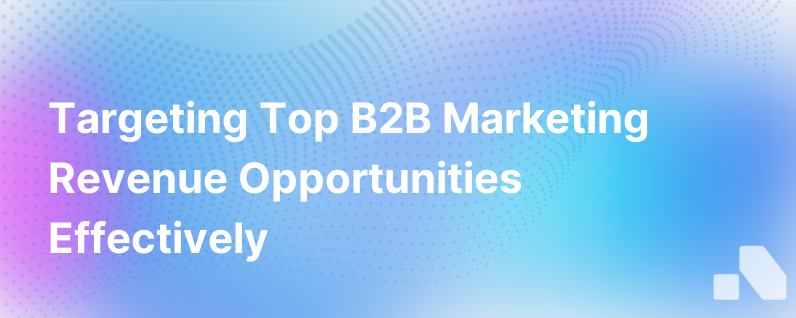
The path to revenue growth in B2B marketing is often fraught with uncertainty. Where should efforts be concentrated? How can you identify and capitalize on the most profitable opportunities? These are central questions, especially for businesses looking to scale in competitive markets.
In this deep dive, we'll outline strategies to hone in on and leverage the best B2B marketing revenue opportunities. We'll explore how to optimize your targeting, refine your value proposition, enhance customer engagement, and maximize the ROI of your marketing campaigns.
Understanding Your Buyer Landscape
To target prime revenue opportunities, it's essential to start with a comprehensive understanding of your buyer landscape. This involves detailed market segmentation to identify high-value prospects.
Key steps include:
- Defining Ideal Customer Profiles (ICPs): Pinpoint characteristics of your ideal buyers, from company size and industry to budget and specific pain points.
- Segmentation: Group prospects based on similarities in needs, buying behavior, or other attributes that dictate how you market to them.
- Account-Based Marketing (ABM): Tailor marketing strategies to high-value accounts, treating them as individual markets to maximize engagement and conversion rates.
Leveraging Data-Driven Insights
Accurate data analysis provides the compass to navigate toward the most profitable marketing ventures. Harness the power of data to uncover:
- Market Trends: Spot emerging patterns or shifts in the market that create opportunities for your product or service.
- Customer Clusters: Identify which segments are growing fastest, most profitable, or untapped.
- Behavioral Insights: Understand your customers' online behavior to tailor your marketing strategies for maximum impact.
Refining Your Value Proposition
Your value proposition sets you apart and must resonate with potential customers. Here's how to refine it:
- Unique Selling Proposition (USP): Clearly articulate what makes your offerings unique compared to competitors.
- Customer Value Alignment: Ensure your USP aligns with customer pain points or goals, emphasizing solutions to their specific challenges.
- Messaging: Sharpen your messaging to consistently reflect your refined value proposition across all marketing collateral and channels.
Optimizing the Marketing Mix
Targeting the right revenue opportunities also involves deploying the right combination of marketing tactics, also known as the marketing mix:
- Content Marketing: Offer valuable insights that address customer pain points, establishing your brand as a thought leader.
- Digital Advertising: Utilize targeted advertising campaigns to reach buyers where they are most active online.
- Email Marketing: Implement segmented email campaigns for ongoing engagement and to nurture leads through the sales funnel.
- Partnerships: Form strategic alliances to expand your reach and tap into new customer bases.
Enablement of Sales Teams
Your salesforce is your frontline battalion for revenue generation, and their enablement is critical:
- Sales Training: Equip your sales team with deep knowledge of the products and how they solve specific customer problems.
- Sales Support Material: Provide battle cards, case studies, and other tools to help them communicate your value proposition effectively.
- Alignment on Targets: Ensure marketing and sales are aligned on target accounts, lead qualification criteria, and expected outcomes.
Using Technology to Your Advantage
Securing high-value opportunities requires integrating the right technological tools:
- Customer Relationship Management (CRM): Use CRM for detailed tracking of customer interactions and history, helping in personalized marketing and sales approaches.
- Marketing Automation: Implement marketing automation to streamline campaign management and lead nurturing efforts.
- Predictive Analytics: Employ predictive analytics to forecast market changes and customer behavior with greater accuracy, allowing for proactive opportunity targeting.
Prioritizing Engagement and Experience
The revenue potential of a prospect can often be gauged by their level of engagement. Prioritize efforts to build and maintain engagement:
- Customer Journeys: Map out and optimize customer journeys to ensure each touchpoint moves prospects closer to conversion.
- Personalization: Use data to personalize experiences, making every interaction feel tailored and relevant to the customer.
- Feedback Loops: Create mechanisms for customer feedback, taking action on insights to improve the customer experience and your offering.
Monitoring and Optimizing Campaign Performance
To ensure your marketing efforts are hitting the mark:
- Tracking and Analytics: Implement robust tracking and analytics to measure campaign performance and customer engagement.
- KPIs and Benchmarks: Establish clear KPIs and benchmarks to measure success and guide optimizations.
- ROI Analysis: Conduct in-depth ROI analysis for each marketing channel and tactic to identify the most profitable efforts.
Building Long-Term Relationships
Short-term wins are valuable, but long-term relationships build sustainable revenue:
- Customer Retention Strategies: Develop retention programs that keep customers engaged and loyal post-purchase.
- Expansion Opportunities: Recognize and act on opportunities to upsell or cross-sell to your existing customer base.
- Advocacy Programs: Encourage satisfied customers to become brand advocates, leveraging their networks to attract more business.
Conclusion
Targeting the best B2B marketing revenue opportunities isn't a task to be taken lightly. It requires a strategic combination of market understanding, data-driven decision making, dynamic value propositions, and the use of technology to streamline operations. By focusing on customer engagement, and building long-term relationships, you can identify and exploit the most lucrative areas for growth in your market.
While the above guide outlines strategies applicable to many B2B enterprises, the exact mix and emphasis will vary based on industry, market conditions, and specific business goals. Aligning sales and marketing efforts, continuously refining tactics based on performance data, and being agile in response to market feedback are hallmarks of companies that excel in this arena. By prioritizing these approaches, your company can position itself to capture the best B2B marketing revenue opportunities, driving sustainable growth and success.